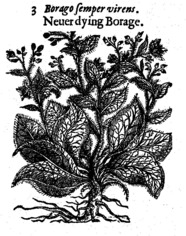
Gerard's Herbal - Part 3
|
|
|
| Fig. 1180. Garden Borage (1) |
Fig. 1181. White-Flowered Borage (2) |
The Description.
1. Borage hath broad leaves, rough, lying flat upon the ground, of a black or swart green colour: among which riseth up a stalk two cubits high, divided into divers branches, whereupon do grow gallant blue flowers, composed of five leaves apiece; out of the middle of which grow forth black threads joined in the top, and pointed like a brooch or pyramid: the root is thready, and cannot away [sic] with the cold of winter.
2. Borage with white flowers is like unto the precedent, but differeth in the flowers: for those of this plant are white, and the others of a perfect blue colour, wherein is the difference.

Fig. 1182. Never-Dying Borage (3)
3. Never-Dying Borage hath many very broad leaves, rough and hairy, of a black dark green colour: among which rise up stiff hairy stalks, whereupon do grow fair blue flowers, somewhat rounder pointed than the former: the root is black and lasting, having leaves both winter and summer, and hereupon it was called sempervirens, and that very properly, to distinguish it from the rest of this kind, which are but annual.
4. There is a fourth sort of Borage that hath leaves like the precedent, but thinner and lesser, rough and hairy, dividing itself into branches at the bottom of the plant, whereupon are placed fair red flowers, wherein is the chiefest difference between this and the last described.
The Place.
These grow in my garden, and in others also.
The Time.
Borage flowers and flourishes most part of all summer, and till autumn be far spent.
The Names.
Borage is called in shops Borago: of the old writers in Latin Lingua bubula: Pliny calleth it Euphrosinum, because it maketh a man merry and joyful: which thing also the old verse concerning Borage doth testify:
Ego Borago gaudia semper ago.
I Borage bring always courage.
It is called in High Dutch Burretsch: in Italian, Boragine: in Spanish, Boraces: in Low Dutch, Beruagie: in English; Borage.
The Temperature.
It is evidently moist, and not in like sort hot, but seems to be in a mean betwixt hot and cold.
The Virtues.
A. Those of our time do use the flowers in salads, to exhilarate and make the mind glad. There be also many things made of them, used everywhere for the comfort of the heart, for the driving away of sorrow, and increasing the joy of the mind.
B. The leaves boiled among other pot-herbs do much prevail in making the belly soluble, they being boiled in honeyed water be also good against the roughness of the throat, and hoarseness, as Galen teacheth.
C. The leaves and flowers of Borage put into wine make men and women glad and merry, and drive away all sadness, dulness, and melancholy, as Dioscorides and Pliny affirm.
D. Syrup made of the flowers of Borage comforteth the heart, purgeth melancholy, and quieteth the frantic or lunatic person.
E. The flowers of Borage made up with sugar do all the aforesaid with greater force and effect.
F. Syrup made of the juice of Borage with sugar, adding thereto powder of the bone of a stag's heart, is good against swooning, the cardiac passion of the heart, against melancholy and the falling sickness.
G. The root is not used in medicine: the leaves eaten raw engender good blood, especially in those that have been lately sick.